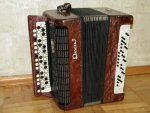D
Deleted member 48
Guest
If you want to play CBA, my advice is: get a unicolour buttons CBA.
In France, most CBAs had a single colour for. all the buttons.
The use of two different colours, eg white and black for diatonic and chromatic music notes, is confusing in a CBA.
In my opinion, starters are better off with a unicolour chromatic buttonboard.
How do other members of this accordion forum feel about this topic?
This idea of a unicolour keyboard can also be used in Janko, Beyreuther, Logicordeon accordions, or Kusserow bandoneons. All of these chromatic layouts.
In France, most CBAs had a single colour for. all the buttons.
The use of two different colours, eg white and black for diatonic and chromatic music notes, is confusing in a CBA.
In my opinion, starters are better off with a unicolour chromatic buttonboard.
How do other members of this accordion forum feel about this topic?
This idea of a unicolour keyboard can also be used in Janko, Beyreuther, Logicordeon accordions, or Kusserow bandoneons. All of these chromatic layouts.


